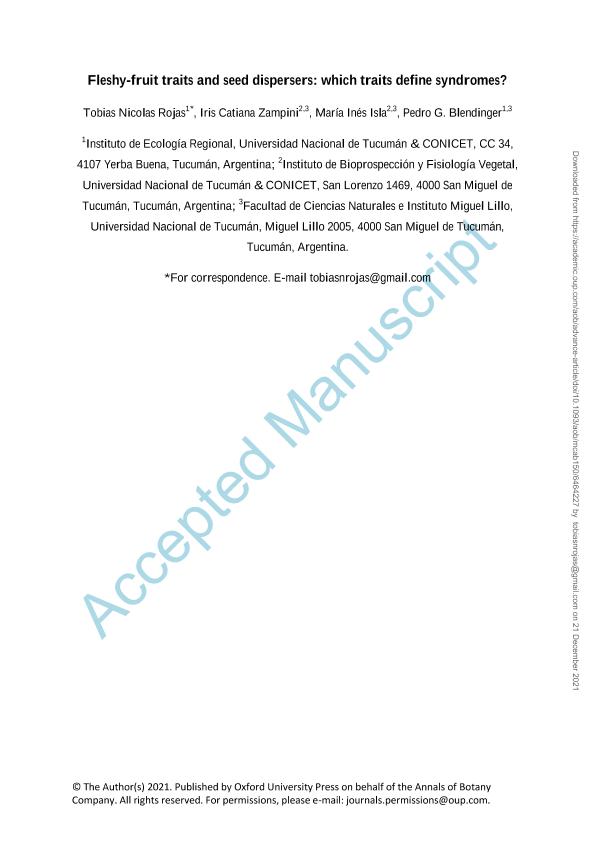Artículo
Fleshy-fruit traits and seed dispersers: which traits define syndromes?
Fecha de publicación:
12/2021
Editorial:
Oxford University Press
Revista:
Annals of Botany
ISSN:
0305-7364
Idioma:
Inglés
Tipo de recurso:
Artículo publicado
Clasificación temática:
Resumen
Background and Aims: Fruit traits and their inter-relationships can affect foraging choices by frugivores, and hence the probability of mutualistic interactions. Certain combinations of fruit traits that determine the interaction with specific seed dispersers are known as dispersal syndromes. The dispersal syndrome hypothesis (DSH) states that seed dispersers influence the combination of fruit traits found in fruits. Therefore, fruit traits can predict the type of dispersers with which plant species interact. Here, we analysed whether relationships of fruit traits can be explained by the DSH. To do so, we estimated the inter-relationships between morphological, chemical and display groups of fruit traits. In addition, we tested the importance of each trait group defining seed dispersal syndromes. Methods: Using phylogenetically corrected fruit trait data and fruit-seed disperser networks, we tested the relationships among morphological, chemical and display fruit traits with Pearson's correlations and phenotypic integration indices. Then, we used perMANOVA to test if the fruit traits involved in the analysis supported the functional types of seed dispersers. Key Results: Morphological traits showed strong intragroup relationships, in contrast to chemical and display traits whose intragroup trait relationships were weak or null. Accordingly, only the morphological group of traits supported three broad seed disperser functional types (birds, terrestrial mammals and bats), consistent with the DSH. Conclusions: Altogether, our results give some support to the DSH. Here, the three groups of traits interacted in different ways with seed disperser biology. Broad functional types of seed dispersers would adjust fruit consumption to anatomical limitations imposed by fruit morphology. Once this anatomical filter is sovercome, seed dispersers use almost all the range of variation in chemical and display fruit traits. This suggests that the effect of seed dispersers on fruit traits is modulated by hierarchical decisions. First, morphological constraints define which interactions can actually occur; subsequently, display and composition determine fruit preferences.
Archivos asociados
Licencia
Identificadores
Colecciones
Articulos(IER)
Articulos de INSTITUTO DE ECOLOGIA REGIONAL
Articulos de INSTITUTO DE ECOLOGIA REGIONAL
Citación
Rojas, Tobias Nicolas; Zampini, Iris Catiana; Isla, Maria Ines; Blendinger, Pedro Gerardo; Fleshy-fruit traits and seed dispersers: which traits define syndromes?; Oxford University Press; Annals of Botany; 129; 7; 12-2021; 831-838
Compartir
Altmétricas
Items relacionados
Mostrando titulos relacionados por título, autor y tema.
-
Blendinger, Pedro Gerardo ; Ruggera, Román Alberto ; Nuñez Montellano, Maria Gabriela ; Macchi, Leandro ; Zelaya, Patricia Viviana ; Alvarez, María Evangelina ; Martín, Eduardo ; Osinaga Acosta, Oriana; Sánchez, Rocío ; Haedo, Josefina (Wiley Blackwell Publishing, Inc, 2012-11)
-
Palacio, Facundo Xavier ; Valoy, M.; Bernacki, F.; Sanchez, Mariano Sebastian ; Nuñez Montellano, Maria Gabriela ; Varela, O.; Ordano, Mariano Andrés (Taylor & Francis, 2017-01)
-
Ruiz Rodríguez, Luciana Gabriela ; Zamora Gasga, Víctor Manuel; Pescuma, Micaela ; Van Nieuwenhove, Carina Paola ; Mozzi, Fernanda Beatriz ; Sánchez Burgos, Jorge Alberto (Elsevier Science, 2021-02)




